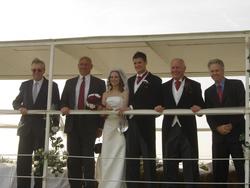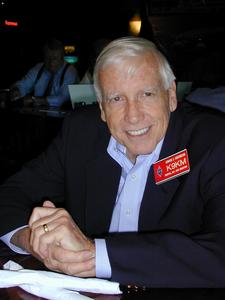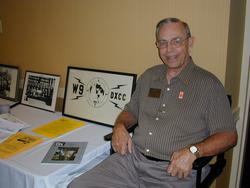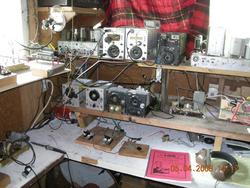 October 1, 2008 Editor: Ward Silver, NØAX | |||||
IN THIS ISSUE
NEW HF OPERATORS - THINGS TO DO The CA QSO Party is a great way to exercise your station in preparation for the fall contest season, especially to log a few of the rarer counties and grids. While you've got your beam pointed at the West Coast, why not listen a little harder and stay up a little later (or get up a little earlier) and put up some points in the Oceania DX Phone contest? The next weekend, try the same trick for the PA QSO Party! BULLETINS There are no bulletins in this issue. BUSTED QSOS
CONTEST SUMMARY Rules follow Commentary section October 4-5
October 11-12
NEWS, PRESS RELEASES, AND GENERAL INTEREST ARRL November Sweepstakes Contest Manager, Ken Adams K5KA notes that with the special award for working 75 sections this year, it would be terrific if all of the sections were extra "radio-active" this year. Ken can't do anything about propagation, but he encourages stations to be on the air for Sweepstakes in lightly-populated sections. Taking a look at the log submissions over the past few years, the following sections have been the hardest to put in the log due to low activity: VE1, VE2, VE4, VE6, VE8/VY1, VE9, VO1/2, VY2, ND, NE, NNY, SD, and WY. If you plan to be active from those sections or would like to host a guest operator, please post a note on the cq-contest reflector. This might be a great year for a Sweepstakes contest expedition!
DX Engineering is expanding its product line by acquiring the stable of Comtek antenna system devices. In case you hadn't noticed, the DX Engineering ads in QST are now two pages of contest-related goodies. (Thanks, Jim W6EU) You might think that contest logging program CT is moribund, but the first radiosport "killer app" is still with us. In fact, author Ken K1EA has just released CT version 10.04! Support has been added for the K3 and IC-703 and the "show mult" function keys Alt-M and Alt-Z have been enhanced. (Thanks, Ken K1EA) Science news is popular with hams and finding the best stories in physics is now easier with the launch of Physics from the American Physical Society. Physics highlights and comments on selected papers, and there are editorials, letters, and news. If you feel the need to keep up on high-temperature superconductivity in the iron pnictides, this is your site! Seriously, Physics is on my morning dog-trot around the 'net and you may enjoy keeping an eye on it, too. At last - a new sunspot! As reported on 22 Sep by spaceweather.com, a significant sunspot is emerging. The magnetic polarity of the sunspot identifies it as a member of new Sunspot Cycle 24. The new sunspot is an encouraging sign that the 11-year solar cycle is indeed progressing, albeit slowly. While this doesn't mean 10 meters will be wall-to-wall signals in this month's CQ World-Wide contest, it's certainly welcome news. (Thanks, Rus K2UA) A new release of the Super Check Partial database files (SCP) is now available. The package includes 46,640 call signs from 3,151 source logs comprising 4,420,380 QSOs - all new record high numbers! If you want to check what version of the SCP files you are using, from within your logging software, enter "VER" in the call sign window with SCP enabled. Every SCP file includes the version number in the list of calls in the format VERYYYYMMDD. Please send Randy K5ZD your logs immediately after each contest. The easiest way is to add k5zd@contesting.com as a cc: address when you email your Cabrillo-formatted log to the contest sponsor's log-acceptance robot. Chris N7ZWY has described a new transmitting loop antenna for 40 meters, in particular a new tuning method that does not involve a series capacitor or gamma matching. This would be handy for portable (and possibly mobile) contest operation where a full-sized antenna would be impractical. A new Macintosh CW training program called "Morse Trainer" has been released by AD5RX and may be downloaded free from Source Forge. The program simulates QRM and QSB and it allows the user to control effective speed and actual speed settings. In addition to those basic features, it offers the ability to set the number of stations QRMing and the ability to read the code back to you (in English) to check your written(or typed) transcription. (Thanks, John W4PAH) If you're planning on operating in the North American RTTY Sprint contest, remember that the rules about duplicate contacts is now the same as for the CW and SSB sprints. (Thanks, Ed W0YK) Folks with rotating tubular masts have a special problem in supporting fixed wire antennas, such as dipoles, inverted-Vees or L's, and so forth. Dick W7ZR solves the problem with a little homebrew ingenuity. Web Site of the Week - John ON4UN and Mark ON4WW have collaborated to produce an IARU-endorsed publication on the topic of operating. The 67-page booklet "Ethics and Operating Procedures for the Radio Amateur", an "Americanized" version of the international version, is available for free download from the ARRL Web site. There are sections on contest operating and procedures that the operator new to the sport will find very helpful. Combined with the ARRL's "HF Contesting - Good Practices, Interpretations, and Suggestions", a lot of questions about how to operate and compete are addressed. WORD TO THE WISE Octopus - a device used to interlock the transmitters at a multi-operator station to prevent simultaneous transmissions. Some contests (such as ARRL Sweepstakes) prohibit the use of interlocking schemes to allow more than one station to "run" at the same time, but interlocking hardware is useful to be sure of complying with the "one signal at a time" or "one signal per band" requirement. SIGHTS AND SOUNDS Second "hops" Peanut and Rooster shine in this QRP-In-The-Field contest video. Trail boss N0TU also made use of the dynamic duo in support of his ARRL September VHF QSO Party effort. Perhaps this will cause his log to be reclassified as MS - Multi-Species! For more about the adventures of Ruminant Power check out Dan's blog.
Cognitive dissonance comes to a head in this rap video about the Large Hadron Collider and what it is intended to discover. Crank it up! (Thanks, Rus K2UA) RESULTS AND RECORDS ARRL Contest Branch Manager, Sean KX9X, writes in to say that, "Certificates for the 2007 Sweepstakes went out the door last week. Plates for the Sweepstakes plaques should be here in the next couple weeks and we have committed to get those out as fast as humanly possible once they arrive. We've received 323 logs for the September VHF Contest so far with the log deadline coming up on October 14th." Sean also announced that the cost of contest plaques would be going up from $67 to $75, beginning with the 2009 ARRL RTTY Roundup - the first cost increase for contest plaques in several years. 193 logs have been received for the August UHF contest, including 23 paper logs. 10 GHz Contest logs are beginning to roll in with most, predictably, being submitted as paper logs; only 7 logs have been received electronically. The results of the September CW Sprint have been released by contest manager Tree N6TR. That's one of the fastest contest results generation anywhere! The results of the 2007 Stew Perry Topband Distance Challenge have also been posted to the Web. Don't forget the October warm-up event to be held on October 18-19th. The main event will be held on December 27-28th. The contest runs for 24 hours starting at 1500 UTC. (Thanks, Tree N6TR) With many people across Ohio (and elsewhere) losing power for days as a result of the recent storms, the log deadline for the Ohio QSO Party has been extended to October 10. (Thanks, Jim K8MR) OPERATING TIP Acknowledging a QSO is important, particularly in short, intense contests like the North American Sprint. Even though you're in a hurry to get to that next QSO, be SURE to positively acknowledge the transmitting station's information. If you don't, the QSO might not be logged, leaving you with a NIL (not-in-log) penalty. On CW, sending a single "dit" is often lost in the noise or under other callers. "R" or "TU" is much better at a very small cost of time. TECHNICAL TOPICS AND INFORMATION Software-defined radio is arriving on the ham radio scene in a big way as this Electronic Design article by Louis Frenzel W5LEF points out. With the arrival of high-speed 16-bit (and wider) A/D converters, the specifications of SDR receivers are approaching those of the best analog receivers. At the TAPR Digital Communications Conference last weekend, SDR was a hot topic with presentations on the HPSDR radio and a great Sunday seminar by Phil VK6AFH whose presentation can be found on the TAPR Web site. (Thanks, Ken K0PP) Writing on the QRP-L reflector, Paul NA5N points out, "If you've never visited an RV joint or a truck stop store, there's a whole new world of nifty gadgets you never knew existed." Paul is referring to the many devices designed to run off of 12 V - the ham's standard power supply voltage. Michael VE3TIX contributes two articles (one multi-part) about bypass capacitors and why different types are used in different applications. Choosing and Using Bypass Capacitors is a three-part article (Part 1, Part 2, Part 3) on the Planet Analog Web site. The second, "Bypass capacitors: no black magic here" is written by Bonnie Baker of Microchip Technology in EDN. Selecting the right kind of bypass capacitors for use around the contest station can make the difference being solving and exacerbating RF problems.
Here's an excellent reference from Pete N4ZR on finding out which house may be the home of a neighborhood noise source. He found a neighbor with an electrically-heated dog dish that had a bad thermostat. Emphasizing the fire risk ("Hear that? That's a spark somewhere on your house wiring!") was instrumental in gaining the cooperation of the homeowner in finding and eliminating the problem. For the electronic student, here's a very thorough online presentation on transistor design - "Principles of Semiconductor Devices" by Bart Van Zeghbroeck. (Thanks, Randy K9OR) The folded-monopole (or folded-unipole) antenna has been around for quite a while, but isn't well-known in amateur radio. Adapted from the broadcast industry, the design involves surrounding a tower with a few wires to provide an "inner" and "outer" conductor, much as a folded-dipole uses two parallel conductors. The resulting higher feed point impedance makes the antenna easier to match. The first two volumes of the ARRL Antenna Compendium series have articles describing this type of antenna. Terman also describes a version in which a wire is dropped down the center of a tower. (Thanks to various Towertalk reflector posts for the information) Batteries may hold the high ground in the portable electrical energy storage wars, but supercapacitor technology is catching up. A recent story on Physorg.com discusses several recent supercapacitor advances. Technical Web Site of the Week - Noted propagation expert and columnist, Carl K9LA, has published a collection of articles on 160 meter propagation. With Top Band season getting under way, these will make great reading while you're waiting for the DX signals to peak! (Thanks, Bill W4ZV) CONVERSATION As I was soaking up Phil VK6APH's excellent seminar on Software-Defined Radio at last weekend's TAPR Digital Communications Conference, I was marveling at the inroads digital technology has made in the thoroughly analog kingdom of RF. Many receivers connect the antenna directly to the input of an A/D converter and nevermore is the analog signal seen until it resurfaces as audio somewhere far downstream for our biological eyes or ears to comprehend. Ah well, no one has digitized propagation yet, although if they had, it would certainly be a '0' at the moment. Where were we at the beginning of Cycle 23? In the mid-1990's, the VK0IR expedition was astounding DXers around the world that signals from the sub-Antarctic Indian Ocean could be heard at the bottom of the solar cycle. The hottest rigs of the day were pure analog with DSP functions just beginning to appear as audio processing gadgetry. Digitizing the RF spectrum was pretty much a pipe dream outside of military and academic labs. A heavily modified Drake R4C was the top dog in strong-signal amateur receiving. Enter cellular telephony. Once the province of the hefty "bag phone", what proved to be insatiable consumer demand created economies of scale that drove innovation and miniaturization to a degree unimaginable only a few years before. Within ten years, a handheld 2 GHz phone could fit in a pocket, take pictures, surf the Web (another nascent technology as the cycle turned), and act as a broadband data terminal. Opening up the phone, one would see only a square IC with a whole lot of hair-thin leads and an epoxy block or two of RF circuitry. Thus RF enters the digital age. Limited only by digitization rate, number of bits, and the cleverness of programmers and FPGA vendors, the radio's largest components will soon be the displays that produce digits and characters large enough for our eyes to discern. Unless humans begin to develop built-in data interfaces, anyway.
So will Cycle 24 be the last cycle for analog radio technology? Given the rate of change we've witnessed over the course of Cycle 23, I'm betting that analog radio will be largely found on the same shelf where the 6L6 and modulation transformer now reside. To be sure, there will always be a home for analog technology in amateur radio, but it will no longer be the subject of cutting-edge product reviews and late-night post-meeting discussions before contest season. With the certain knowledge of the coming changes, it is at our own peril we ignore them. It's time to start paying attention to those tutorial articles, demonstrations, and new product reviews. Radio-the-technology won't displace the enjoyment we receive from radio-the-art. As Cycle 24 emerges, opening bands long closed, we'll find new call signs on the air from unexpected places. Just as surely, we'll also find and enjoy new technology creeping onto our operating desks, replacing equipment long used, bit by bit. CONTESTS 1 October through 14 October 2008 An expanded, downloadable version of QST's Contest Corral in PDF format is available. Check the sponsor's Web site for information on operating time restrictions and other instructions. HF CONTESTS YLRL Anniversary Party--CW, from 3 Oct 1400Z to 5 Oct 0200Z. Bands (MHz): 1.8-28. Exchange: Serial, RST, and section/province/country. Logs due: 30 days. Rules PSK Rumble - The Fall Classic--Digital, from 4 Oct 0000Z to 4 Oct 2400Z. Bands (MHz): 1.8-28, 50. Exchange: Name and S/P/C. Logs due: 29 Oct. Rules Oceania DX Phone Contest--Phone, from 4 Oct 0800Z to 5 Oct 0800Z. Bands (MHz): 1.8-28. Exchange: RS and serial. Logs due: 10 Nov. Rules EU Autumn Sprint--Phone, from 4 Oct 1600Z to 4 Oct 1959Z. Bands (MHz): 3.5-14. Exchange: Both call signs, serial, name. Logs due: 15 days. Rules California QSO Party--Phone,CW, from 4 Oct 1600Z to 5 Oct 2159Z. Bands (MHz): 1.8-28, 50, 144. Exchange: Serial and state/prov/"DX" or CA county. Logs due: 15 Nov. Rules RSGB 21/28 MHz Contest--Phone,CW, from 5 Oct 0700Z to 5 Oct 1900Z. Bands (MHz): 21,28. Exchange: Serial and UK district. Logs due: 20 Oct. Rules 10-10 Sprint--Phone,CW,Digital, from 10 Oct 0001Z to 10 Oct 2359Z. Bands (MHz): 28. Exchange: Call, name, 10-10 number, S/P/C. Logs due: 25 Oct. Rules YLRL Anniversary Party--Phone, from 10 Oct 1400Z to 12 Oct 0200Z. Bands (MHz): 1.8-28. Exchange: Serial, RS, and section/province/country. Logs due: 30 days. Rules Oceania DX CW Contest--CW, from 11 Oct 0800Z to 12 Oct 0800Z. Bands (MHz): 1.8-28. Exchange: RST and serial. Logs due: 10 Nov. Rules Worked All Britain HF Contest--Phone, from 11 Oct 1200Z to 12 Oct 1200Z. Bands (MHz): 14-28. Exchange: RS, serial, DXCC entity or WAB area. Logs due: 2 Nov. Rules EU Autumn Sprint--CW, from 11 Oct 1600Z to 11 Oct 1959Z. Bands (MHz): 3.5-14. Exchange: Both call signs, serial, name. Logs due: 15 days. Rules Pennsylvania QSO Party--Phone,CW,Digital, from 11 Oct 1600Z to 12 Oct 0500Z and 12 Oct 1300Z to 12 Oct 2200Z. Bands (MHz): 1.8-28, 50, 144, CW-1.81 & 40 kHz above band edge, Phone-1.85, 3.98, 7.28, 14.28, 21.38, 28.48, PSK31 calling freq, mobile 5 kHz lower. Exchange: Serial and ARRL/RAC section. Logs due: 12 Nov. Rules FISTS Fall Sprint--CW, from 11 Oct 1700Z to 11 Oct 2100Z. Bands (MHz): 3.5-28. Exchange: RST, S/P/C, name, FISTS number or pwr. Logs due: 30 days. Rules North American RTTY Sprint--Digital, from 12 Oct 0000Z to 12 Oct 0400Z. Bands (MHz): 3.5-14. See Web site for new dupe rule. Exchange: Both call signs, serial, QTH, name. Logs due: 7 days. Rules SKCC Weekend Sprint--CW, from 12 Oct 0000Z to 12 Oct 2359Z. Bands (MHz):3.5-28, 3.550, 7.055, 7.120, 14.050, 21.050, 28.050. Exchange: S/P/C, SKCC number or power. Rules Classic Exchange--CW, from 12 Oct 1300Z to 13 Oct 0700Z. Bands (MHz):1.8-28, 50, 144, 1.810, 3.545, 7.045, 14.045, 21.135, 28.050, 50.100, 144.100 . Exchange: Name, RS, S/P/C, type of equipment. Rules VHF+ CONTESTS PSK Rumble - The Fall Classic--Digital, from 4 Oct 0000Z to 4 Oct 2400Z. Bands (MHz): 1.8-28, 50. Exchange: Name and S/P/C. Logs due: 29 Oct. Rules California QSO Party--Phone,CW, from 4 Oct 1600Z to 5 Oct 2159Z. Bands (MHz): 1.8-28, 50, 144. Exchange: Serial and state/prov/"DX" or CA county. Logs due: 15 Nov. Rules Fall VHF Sprints--Phone,CW,Digital, from 8 Oct 7 PM to 8 Oct 11 PM. Bands (MHz): 432. Exchange: Grid square. Logs due: 4 weeks. Rules Pennsylvania QSO Party--Phone,CW,Digital, from 11 Oct 1600Z to 12 Oct 0500Z and 12 Oct 1300Z to 12 Oct 2200Z. Bands (MHz): 1.8-28, 50, 144, CW-1.81 & 40 kHz above band edge, Phone-1.85, 3.98, 7.28, 14.28, 21.38, 28.48, PSK31 calling freq, mobile 5 kHz lower. Exchange: Serial and ARRL/RAC section. Logs due: 12 Nov. Rules Classic Exchange--CW, from 12 Oct 1300Z to 13 Oct 0700Z. Bands (MHz):1.8-28, 50, 144, 1.810, 3.545, 7.045, 14.045, 21.135, 28.050, 50.100, 144.100 . Exchange: Name, RS, S/P/C, type of equipment. Rules LOG DUE DATES 1 October through 14 October 2008 October 1 - MI QRP Labor Day CW Sprint, email logs to: n8xx@arrl.org, paper logs and diskettes to: Hank Greeb, N8XX, 5727 11 Mile Rd NE, Rockford, MI 49341, USA. Rules October 1 - Russian RTTY WW Contest, email logs to: contest@radio.ru, paper logs and diskettes to: Russian RTTY WW Contest, Radio Magazine, Seliverstov per. 10, Moscow 107045, Russia. Rules October 1 - Feld Hell Sprint, email logs to: (none), post log summary at: http://www.bambinomusical.com/autolog.html, paper logs and diskettes to: (none). Rules October 1 - RSGB 80m Club Sprint, CW, email logs to: cwsprint.logs@rsgbhfcc.org, Upload log at: http://www.vhfcc.org/cgi-bin/hfcover.pl, paper logs and diskettes to: (none). Rules October 1 - SEDXC 50th Anniversary Contest, email logs to: sedxc50@sedxc.org, paper logs and diskettes to: WB4SQ, 730 Wickerberry Knoll, Roswell, GA 30075, USA. Rules October 6 - SARL VHF/UHF Contest, email logs to: zs6pjb@gmail.com, paper logs and diskettes to: VHF Contest Manager, Piet Badenhorst, PO Box 4452, White River, 1240, South Africa. Rules October 7 - DARC 10-Meter Digital Contest, email logs to: df5bx@darc.de, paper logs and diskettes to: Werner Ludwig, DF5BX, PO Box 1270, 49110 Georgsmarienhuette, Germany. Rules October 7 - International G3ZQS Memorial Straight Key Contest, email logs to: hallinl@lanecc.edu, paper logs and diskettes to: Lee Hallin N7NU, 3413 Walton Ln, Eugene OR 97408, USA. Rules October 9 - Tennessee QSO Party, email logs to: logs@tnqp.org, paper logs and diskettes to: Tennessee QSO Party, c/o Doug Smith, W9WI, 1389 Old Clarksville Pike, Pleasant View, TN 37146-8098, USA. Rules October 9 - BCC QSO Party, email logs to: qsoparty@bavarian-contest-club.de, paper logs and diskettes to: (none). Rules October 10 - Ohio QSO Party, email logs to: logs@oqp.us, paper logs and diskettes to: Ohio QSO Party, c/o Jim Stahl, K8MR, 30499 Jackson Rd, Chagrin Falls, OH 44022-1730, USA. Rules October 10 - SARTG WW RTTY Contest, email logs to: contest@sartg.com, paper logs and diskettes to: SARTG Contest Manager, Ewe Hakansson, SM7BHM, Pilspetsvagen 4, SE-29166 Kristianstad, Sweden. Rules October 12 - PODXS 070 Club 80m Autumn Sprint, email logs to: jbudzowski@verizon.net, paper logs and diskettes to: Jay Budzowski, N3DQU, 109 S Northview Ave, New Castle, PA 16102, USA. Rules October 13 - AGCW VHF/UHF Contest, email logs to: vhf-uhf@agcw.de, paper logs and diskettes to: Manfred Busch, DK7ZH, Ebachstr 13, D-35716 Dietzhoelztal-Mandeln, Germany. Rules October 13 - Swiss HTC QRP Sprint, email logs to: HB9BQB@uska.ch, paper logs and diskettes to: Guido Giannini, HB9BQB, Kleinzelglistrasse 6, CH-8952 Schlieren, Switzerland. Rules October 13 - SOC Marathon Sprint, email logs to: n4bp@bellsouth.net, paper logs and diskettes to: Bob Patten, N4BP, 2841 NW 112 Terrace, Plantation, FL 33323, USA. Rules October 14 - ARRL September VHF QSO Party, email logs to: SeptemberVHF@arrl.org, paper logs and diskettes to: September VHF, ARRL, 225 Main St, Newington, CT 06111, USA. Rules October 14 - ARCI End of Summer Digital Sprint, email logs to: contest@qrparci.org, paper logs and diskettes to: End Of Summer PSK-31 Sprint, c/o Jeff Hetherington, VA3JFF, 139 Elizabeth St W, Welland, Ontario L3C 4M3, Canada. Rules October 14 - Arkansas QSO Party, email logs to: info@arkanhams.org, paper logs and diskettes to: ARKAN - AA5AR, PO Box 9701, Fayetteville, AR 72703, USA. Rules October 14 - FISTS Get Your Feet Wet Weekend, email logs to: hallinl@lanecc.edu, paper logs and diskettes to: Lee Hallin N7NU, 3413 Walton Ln, Eugene OR 97408, USA. Rules ACKNOWLEDGEMENTS ARRL Contest Update wishes to acknowledge information from WA7BNM's Contest Calendar and SM3CER's Contest Calendar. | |||||










